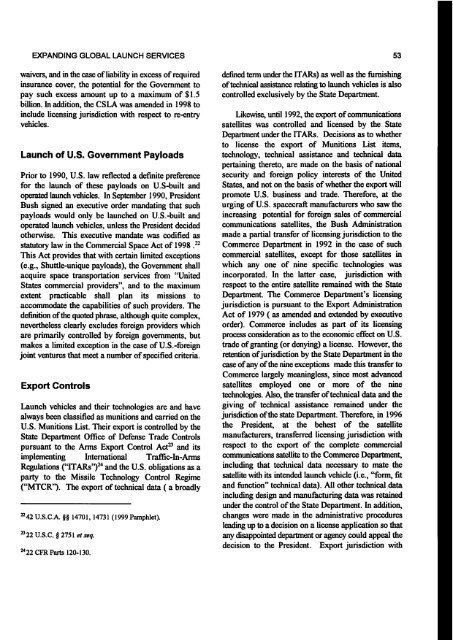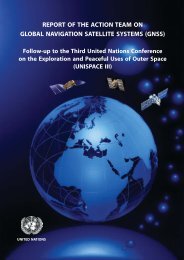Proceedings of the Workshop - United Nations Office for Outer ...
Proceedings of the Workshop - United Nations Office for Outer ...
Proceedings of the Workshop - United Nations Office for Outer ...
- No tags were found...
You also want an ePaper? Increase the reach of your titles
YUMPU automatically turns print PDFs into web optimized ePapers that Google loves.
EXPANDING GLOBAL LAUNCH SERVICES 53waivers, and in <strong>the</strong> case <strong>of</strong> liability in excess <strong>of</strong> requiredinsurance cover, <strong>the</strong> potential <strong>for</strong> <strong>the</strong> Government topay such excess amount up to a maximum <strong>of</strong> $1.5billion. In addition, <strong>the</strong> CSLA was amended in 1998 toinclude licensing jurisdiction with respect to re-entryvehicles.Launch <strong>of</strong> U.S. Government PayloadsPrior to 1990, U.S. law reflected a definite preference<strong>for</strong> <strong>the</strong> launch <strong>of</strong> <strong>the</strong>se payloads on U.S-built andoperated launch vehicles. In September 1990, PresidentBush signed an executive order mandating that suchpayloads would only be launched on U.S.-built andoperated launch vehicles, unless <strong>the</strong> President decidedo<strong>the</strong>rwise. This executive mandate was codified asstatutory law in <strong>the</strong> Commercial Space Act <strong>of</strong> 1998 .22This Act provides that with certain limited exceptions(e.g., Shuttle-unique payloads), <strong>the</strong> Government shallacquire space transportation services from “<strong>United</strong>States commercial providers”, and to <strong>the</strong> maximumextent practicable shall plan its missions toaccommodate <strong>the</strong> capabilities <strong>of</strong> such providers. Thedefinition <strong>of</strong> <strong>the</strong> quoted phrase, although quite complex,never<strong>the</strong>less clearly excludes <strong>for</strong>eign providers whichare primarily controlled by <strong>for</strong>eign governments, butmakes a limited exception in <strong>the</strong> case <strong>of</strong> U.S.-<strong>for</strong>eignjoint ventures that meet a number <strong>of</strong> specified criteria.Export ControlsLaunch vehicles and <strong>the</strong>ir technologies are and havealways been classified as munitions and carried on <strong>the</strong>U.S. Munitions List. Their export is controlled by <strong>the</strong>State Department <strong>Office</strong> <strong>of</strong> Defense Trade Controlspursuant to <strong>the</strong> Arms Export Control Act23 and itsimplementing International Traffic-In-ArmsRegulations (“ITARs”)24 and <strong>the</strong> U.S. obligations as aparty to <strong>the</strong> Missile Technology Control Regime(“MTCR”). The export <strong>of</strong> technical data ( a broadly22 42 U.S.C.A. §§ 14701, 14731 (1999 Pamphlet).232 2 U.S.C. §2751 e t seq.242 2 CFR Parts 120-130.defined term under <strong>the</strong> ITARs) as well as <strong>the</strong> furnishing<strong>of</strong> technical assistance relating to launch vehicles is alsocontrolled exclusively by <strong>the</strong> State Department.Likewise, until 1992, <strong>the</strong> export <strong>of</strong> communicationssatellites was controlled and licensed by <strong>the</strong> StateDepartment under <strong>the</strong> ITARs. Decisions as to whe<strong>the</strong>rto license <strong>the</strong> export <strong>of</strong> Munitions List items,technology, technical assistance and technical datapertaining <strong>the</strong>reto, are made on <strong>the</strong> basis <strong>of</strong> nationalsecurity and <strong>for</strong>eign policy interests <strong>of</strong> <strong>the</strong> <strong>United</strong>States, and not on <strong>the</strong> basis <strong>of</strong> whe<strong>the</strong>r <strong>the</strong> export willpromote U.S. business and trade. There<strong>for</strong>e, at <strong>the</strong>urging <strong>of</strong> U.S. spacecraft manufacturers who saw <strong>the</strong>increasing potential <strong>for</strong> <strong>for</strong>eign sales <strong>of</strong> commercialcommunications satellites, <strong>the</strong> Bush Administrationmade a partial transfer <strong>of</strong> licensing jurisdiction to <strong>the</strong>Commerce Department in 1992 in <strong>the</strong> case <strong>of</strong> suchcommercial satellites, except <strong>for</strong> those satellites inwhich any one <strong>of</strong> nine specific technologies wasincorporated. In <strong>the</strong> latter case, jurisdiction withrespect to <strong>the</strong> entire satellite remained with <strong>the</strong> StateDepartment. The Commerce Department’s licensingjurisdiction is pursuant to <strong>the</strong> Export AdministrationAct <strong>of</strong> 1979 ( as amended and extended by executiveorder). Commerce includes as part <strong>of</strong> its licensingprocess consideration as to <strong>the</strong> economic effect on U.S.trade <strong>of</strong> granting (or denying) a license. However, <strong>the</strong>retention <strong>of</strong> jurisdiction by <strong>the</strong> State Department in <strong>the</strong>case <strong>of</strong> any <strong>of</strong> <strong>the</strong> nine exceptions made this transfer toCommerce largely meaningless, since most advancedsatellites employed one or more <strong>of</strong> <strong>the</strong> ninetechnologies. Also, <strong>the</strong> transfer <strong>of</strong> technical data and <strong>the</strong>giving <strong>of</strong> technical assistance remained under <strong>the</strong>jurisdiction <strong>of</strong> <strong>the</strong> state Department. There<strong>for</strong>e, in 1996<strong>the</strong> President, at <strong>the</strong> behest <strong>of</strong> <strong>the</strong> satellitemanufacturers, transferred licensing jurisdiction withrespect to <strong>the</strong> export <strong>of</strong> <strong>the</strong> complete commercialcommunications satellite to <strong>the</strong> Commerce Department,including that technical data necessary to mate <strong>the</strong>satellite with its intended launch vehicle (i.e., “<strong>for</strong>m, fitand function” technical data). All o<strong>the</strong>r technical dataincluding design and manufacturing data was retainedunder <strong>the</strong> control <strong>of</strong> <strong>the</strong> State Department. In addition,changes were made in <strong>the</strong> administrative proceduresleading up to a decision on a license application so thatany disappointed department or agency could appeal <strong>the</strong>decision to <strong>the</strong> President. Export jurisdiction with
















